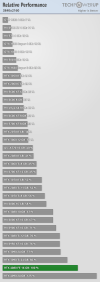Rumor mill: The rumored specifications of Nvidia's upcoming next-generation flagship graphics card have shifted back and forth over the last several months. However, the latest report from a verified leaker suggests that it will feature more memory than prior estimates. The new performance king might also draw unprecedented wattages.

Trusted tipster @kopite7kimi recently shared the basic specifications for the top two products in Nvidia's next series of desktop GPUs, codenamed Blackwell. Both appear to present substantial upgrades over their predecessors in multiple areas.
The lineup's top card, presumably called the GeForce RTX 5090, will include 32GB of GDDR7 VRAM on a 512-bit memory bus. This configuration is significantly larger and faster than the most powerful GPU currently available – the 4090 – which features 24GB of GDDR6X VRAM on a 384-bit bus. Earlier reports suggested that the 5090 might have 28GB on a 448-bit bus, and whether future reports could shift again remains unclear.
GeForce RTX 5090
– kopite7kimi (@kopite7kimi) September 26, 2024
PG144/145-SKU30
GB202-300-A1
21760FP32
512-bit GDDR7 32G
600W
Kopite's projected CUDA core count offers another dramatic leap, increasing to 21,760 over the 4090's 16,384. The leaker also reaffirmed his previous report that the 5090 will consume 600W. The 4090 was feared to be a 600W card before its launch but only draws 450W. When MSI's new high-end power supplies were discovered to feature two 16-pin power connectors, speculation arose that the 5090 might need both, necessitating a new PSU purchase for all consumers.
Meanwhile, the second Blackwell GPU, the RTX 5080, will feature 10,752 CUDA cores to the 4080's 9,728. As previously rumored, its TDP grows to 400W from its predecessor's 320W.
GeForce RTX 5080
– kopite7kimi (@kopite7kimi) September 26, 2024
PG144/147-SKU45
GB203-400-A1
10752FP32
256-bit GDDR7 16G
400W
However, for some models, Blackwell might see Nvidia continue its unpopular practice of skimping on VRAM. The 5080, like the 4080, will include only 16GB of memory on a 256-bit bus, with the shift to GDDR7 being the only upgrade. Prior reports indicated that the RTX 5070 will also employ GDDR7 RAM, but lower-tier variants will continue using GDDR6X.
Other important details that remain under wraps include clock speeds, tensor cores, ray-tracing cores, price, and more. Overall, the 5090 is rumored to offer a 70 percent performance improvement over the 4090.
Nvidia is expected to unveil Blackwell at CES 2025 in January. AMD might also introduce its next-generation RDNA 4 GPUs at the event, but the lineup will only feature mid-range and mainstream products, which sell more units. Meanwhile, Intel might begin shipping its upcoming Arc Battlemage series in late 2024.
